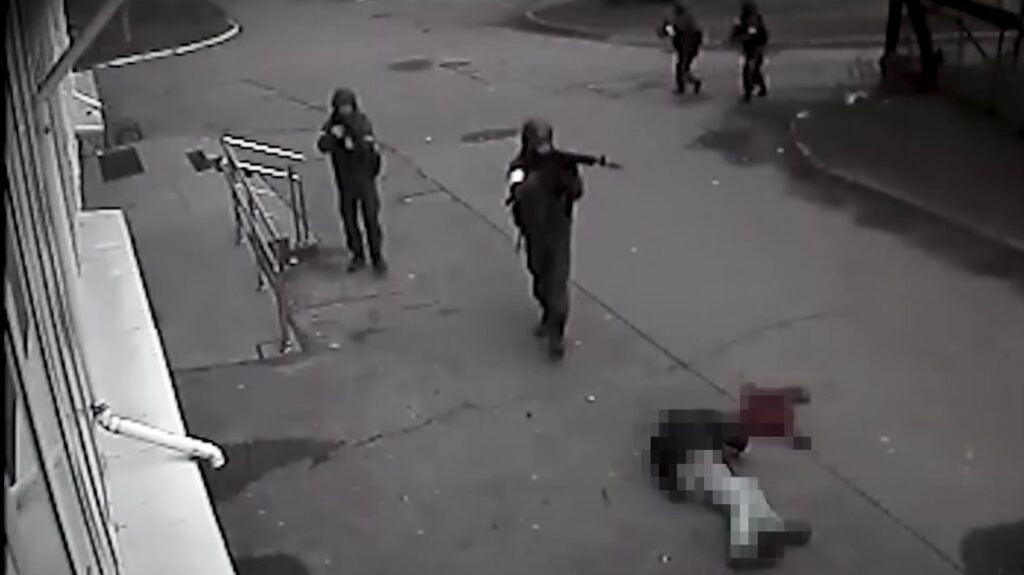Unseen footage shows another evidence of Russian war crimes: troops kill Bucha civilian, steal goods while body remains on street

Radio Svoboda journalists have released previously unseen surveillance camera footage documenting the killing of 70-year-old Bucha resident Volodymyr Rubailo by Russian military personnel on Yablunska Street on 4 March 2022.
The video recordings, published by Radio Liberty on 6 August, show Russian soldiers first wounding Volodymyr Rubailo with an initial shot, then executing him with a targeted shot to the head while the civilian man could barely stand on his feet. Shortly after, Russian military personnel began systematically looting a grocery supermarket near Rubailo’s body, which remained on the ground throughout the incident.
“They broke the glass and went inside. They put the stolen goods in baskets and bags and loaded them onto armored vehicles. To take more, some filled shopping carts and wheeled them down the street to the houses of Bucha residents they had just captured,” Radio Svoboda journalists reported.
The publication previously reported that Russian paratroopers from the 234th Airborne Assault Regiment from Pskov may be involved in Rubailo’s murder, specifically a group led by Sergeant Vladimir Borzunov. Radio Svoboda established that his unit was positioned at the location from which, according to Ukrainian ballistics experts, the shots were fired at the Bucha civilian.
In a telephone conversation with a Radio Svoboda correspondent, Sergeant Borzunov confirmed that Russian military personnel killed Rubailo but denied his involvement and that of his subordinates in the civilian’s murder.
On 24 June, law enforcement officials identified three additional Russian military personnel involved in the killings of civilians during the temporary occupation of part of Kyiv Oblast. On 3 July, prosecutors sent the cases of four Russian servicemen accused of shooting civilians in Bucha to court.
Background: Bucha occupation and liberation
Bucha remained under occupation for 33 days. Russian military forces with heavy equipment entered Bucha on the morning of 27 February 2022. That same day, a missile hit a residential building, and mayor Anatoly Fedoruk reported the first casualties.
Russian forces left the city on 31 March 2022. On the evening of 2 April, the Ministry of Defense officially announced that all settlements in Kyiv Oblast had been liberated from Russian military forces.
When journalists and Ukrainian military personnel reached the city after Bucha’s liberation, they discovered evidence of mass killings. Some bodies were found on the streets, others with hands tied behind their backs. Ukraine officially called on the world to join the investigation into the murders of civilians in Bucha. On 14 April 2024, International Criminal Court Prosecutor Karim Khan personally visited Bucha.
On 8 April 2022, authorities began exhuming bodies from a mass grave near the Church of St. Andrew the First-Called and All Saints in Bucha to identify the victims and establish the circumstances of their deaths. Private American company Maxar Technologies reported that the first signs of the mass grave near the church were captured in satellite images on 10 March 2022.
Law enforcement officials have documented over 9,000 war crimes committed by the Russian army during the occupation of the Bucha district in Kyiv Oblast. More than 1,700 civilians died. During 2022 alone, law enforcement managed to identify 91 Russian military personnel who committed war crimes. The Armed Forces of Ukraine reported they had eliminated Russian soldiers who tortured civilians in Bucha.

Thanks to your incredible support, we’ve raised 70% of our funding goal to launch a platform connecting Ukraine’s defense tech with the world – David vs. Goliath defense blog. It will support Ukrainian engineers who are creating innovative battlefield solutions and we are inviting you to join us on the journey.
Our platform will showcase the Ukrainian defense tech underdogs who are Ukraine’s hope to win in the war against Russia, giving them the much-needed visibility to connect them with crucial expertise, funding, and international support.
We’re one final push away from making this platform a reality.
